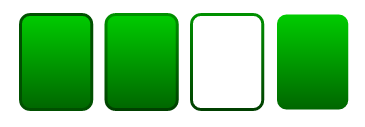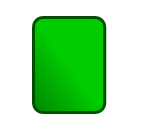SVG渐变是填充SVG图形的一种方法。通过填充渐变色,可以使SVG图形的填充色或描边色由一种颜色过渡到另一种颜色。在某些时候对SVG图形填充渐变色可以得到非常好看的效果。
SVG渐变的例子
下面展示了在SVG图形上使用填充渐变和描边渐变的几个小例子:

在上面的例子中,第一个矩形的描边色没有使用渐变色,填充色使用从浅绿到深绿色的渐变。第二个矩形填充色和渐变色都使用从浅绿到深绿色的渐变。第三个矩形没有填充色,描边色使用从浅绿到深绿色的渐变。第四个矩形填充色使用从浅绿到深绿色的渐变,没有使用描边。
我们可以使用两种类型的渐变:
线性渐变
径向渐变
线性渐变
线性渐变是指从一种颜色到另一种颜色的线性变化。在前面的例子中使用的都是线性渐变。
线性渐变的方向可以是水平方向或垂直方向,也可以是你指定的一个角度的方向。你也可以只为SVG图形的某一部分填充渐变色,而不是整个SVG图形。下面是一些使用线性渐变填充SVG矩形的例子:
第一个矩形使用的是垂直渐变,第二个矩形使用的是水平渐变,第三个矩形使用的是对角渐变(渐变色从左上角到右下角),第四个矩形仅仅在右侧使用渐变色来填充。
我们可以使用
<svg xmlns="http://www.w3.org/2000/svg"
xmlns:xlink="http://www.w3.org/1999/xlink">
<defs>
<linearGradient id="myLinearGradient1"
x1="0%" y1="0%"
x2="0%" y2="100%"
spreadMethod="pad">
<stop offset="0%" stop-color="#00cc00" stop-opacity="1"/>
<stop offset="100%" stop-color="#006600" stop-opacity="1"/>
</linearGradient>
</defs>
<rect x="10" y="10" width="75" height="100" rx="10" ry="10"
style="fill:url(#myLinearGradient1);
stroke: #005000;
stroke-width: 3;" />
可以看到,元素是嵌套在
元素中有两个嵌套的元素控制渐变的方向,而
下面的表格中列出了元素的一些属性及其描述。
属性 |
描述 |
| id | 渐变的唯一ID号,用于在图形中引用该渐变 |
| x1, y1 | x1, y1定义渐变的起点。使用的是百分比数值 |
| x2, y2 | x2, y2定义渐变的终点。使用的是百分比数值 |
| spreadMethod | 这个参数定义渐变的传播方式。可取值有3个:pad,repeat和reflect。pad是指开始和结束颜色平铺填充整个渐变。repeat是指渐变在整个图形中不断重复。reflect是指渐变在图形中会镜像显示。这个参数只有在渐变没有填充满整个图形时才有效果。(可以参看 |
| gradientTransform | 可以使用该参数在应用一个渐变之前对其进行转换(如旋转) |
| gradientUnits | 设置计算 x1, y1 和 x2,y2的方式 |
| xlink:href | 设置这个渐变继承自另一个渐变,取值为另一个渐变的ID号。换句话说,如果这个渐变没有设置其它属性值,它将使用ID指向的那个渐变作为默认的渐变 |
下面的表格中列出了
属性 |
描述 |
| offset | 设置渐变的开始和结束颜色距离渐变两端的距离。使用渐变的百分比值来设置。例如,10%表示渐变进入图形内部10%的距离 |
| stop-color | 渐变停止点的颜色 |
| stop-opacity | 该渐变停止点的颜色透明度。 |
关于这些属性通过图像来说明比较清晰,来看下面的图像:
下面的代码是上图中渐变定义的代码:
<svg xmlns="http://www.w3.org/2000/svg"
xmlns:xlink="http://www.w3.org/1999/xlink">
<defs>
<linearGradient id="myLinearGradient1"
x1="0%" y1="0%"
x2="100%" y2="0%"
spreadMethod="pad">
<stop offset="10%" stop-color="#00cc00" stop-opacity="1"/>
<stop offset="30%" stop-color="#006600" stop-opacity="1"/>
<stop offset="70%" stop-color="#cc0000" stop-opacity="1"/>
<stop offset="90%" stop-color="#000099" stop-opacity="1"/>
</linearGradient>
</defs>
<rect x="10" y="10" width="500" height="50" rx="10" ry="10"
style="fill:url(#myLinearGradient1); stroke: #005000;
stroke-width: 3;" />
</svg> 第一个颜色停止点是#00cc00,它位于矩形边部10%的地方。因为spreadMethod属性被设置为pad,在矩形0-10%距离的地方仍然使用第一种颜色#00cc00来填充。
在第一个颜色停止点之后是第二个颜色停止点,它的颜色是#006600,位于矩形边部30%距离的地方。
第三个颜色停止点的颜色是#cc0000,位于矩形边部70%距离的地方。
第四个颜色停止点的颜色是#000099,位于矩形边部90%距离的地方。在这之后的矩形颜色使用第四个颜色停止点的颜色来填充,因为code>spreadMethod属性被设置为pad。
径向渐变
径向渐变是一种圆形的颜色渐变方式。下面是几个例子:
在上面的例子中,最后三个绿色的径向渐变分别将渐变的中心设置在不同的位置上,其它都相同,得到的效果却有所不同。第一个绿色径向将被的中心位于矩形的中心位置,第二个绿色径向渐变的中心位于矩形的上边部中心位置,第三个绿色径向渐变的中心位于军训的左上角位置。
我们可以使用0649cc1cc16c8306177acf255def2211元素来定义颜色径向渐变。下面是一个例子:
<svg xmlns="http://www.w3.org/2000/svg"
xmlns:xlink="http://www.w3.org/1999/xlink">
<defs>
<radialGradient id="myRadialGradient4"
fx="5%" fy="5%" r="65%"
spreadMethod="pad">
<stop offset="0%" stop-color="#00ee00" stop-opacity="1"/>
<stop offset="100%" stop-color="#006600" stop-opacity="1" />
</radialGradient>
</defs>
<rect x="340" y="10" width="100" height="100" rx="10" ry="10"
style="fill:url(#myRadialGradient4);
stroke: #005000; stroke-width: 3;" />
</svg> 上面的代码实际上是前面例子中第四个绿色径向渐变的代码。在径向渐变中,颜色停止点
下面的表格中列出了
属性 |
描述 |
| id | 用于在图形上引用该渐变的唯一标识符 |
| cx,cy | 径向渐变的中心点X和Y坐标。它的值使用用填充的百分比值。如果没有定义则默认值为50% |
| fx, fy | 径向渐变的焦点X和Y值。它的值使用用填充的百分比值。如果没有定义则默认值为50%。 注意:在Firefox 3.05中如果值低于5%可能会发生问题。 |
| r | 径向渐变的半径 |
| spreadMethod | 定义径向渐变的传播方式。可取值有3个:pad,repeat和reflect。pad是指开始和结束颜色平铺填充整个渐变。repeat是指渐变在整个图形中不断重复。reflect是指渐变在图形中会镜像显示。这个参数只有在渐变没有填充满整个图形时才有效果。 |
| gradientTransform | 可以使用该参数在应用一个渐变之前对其进行转换(如旋转) |
| gradientUnits | 设置计算 x1, y1 和 x2,y2的方式 |
| xlink:href | 设置这个渐变继承自另一个渐变,取值为另一个渐变的ID号。换句话说,如果这个渐变没有设置其它属性值,它将使用ID指向的那个渐变作为默认的渐变 |
径向渐变的聚焦点是颜色辐射的角度。你可以将径向渐变想象为一盏灯,那么聚焦点决定灯光从什么方向“照射”在图形上。50%,50%表示在图形的正上方,5%,5%表示在图形的左上角位置。
为了更好的理解径向渐变的中心点和聚焦点,你最好亲自动手分别设置一些它们不同的值,观察得到的不同效果。
渐变的转换
你可以使用标准的SVG转换函数来对渐变进行各种转换。可以在bffa9ad35fc32d811cd3bf50cdea268e和0649cc1cc16c8306177acf255def2211元素中使用gradientTransform属性来进行渐变的转换。下面是一个例子:
<svg xmlns="http://www.w3.org/2000/svg"
xmlns:xlink="http://www.w3.org/1999/xlink">
<defs>
<linearGradient id="myLinearGradient1"
x1="0%" y1="0%"
x2="0%" y2="100%"
spreadMethod="pad"
gradientTransform="rotate(45)"
>
<stop offset="0%" stop-color="#00cc00" stop-opacity="1"/>
<stop offset="100%" stop-color="#006600" stop-opacity="1"/>
</linearGradient>
</defs>
<rect x="10" y="10" width="75" height="100" rx="10" ry="10"
style="fill:url(#myLinearGradient1);
stroke: #005000;
stroke-width: 3;" />
</svg>
这个例子定义了一个带gradientTransform()属性的线性渐变,gradientTransform()属性中将渐变旋转45度。正常情况下这个线性渐变是从上到下的渐变,但是使用了渐变转换之后,渐变变为从右上角到左下角的渐变。
下面是上面代码的返回结果:
以上就是SVG进阶|SVG渐变(SVG GRADIENTS)的内容,更多相关内容请关注PHP中文网(www.php.cn)!
 How to Add Audio to My HTML5 Website?Mar 10, 2025 pm 03:01 PM
How to Add Audio to My HTML5 Website?Mar 10, 2025 pm 03:01 PMThis article explains how to embed audio in HTML5 using the <audio> element, including best practices for format selection (MP3, Ogg Vorbis), file optimization, and JavaScript control for playback. It emphasizes using multiple audio f
 How do I use viewport meta tags to control page scaling on mobile devices?Mar 13, 2025 pm 08:00 PM
How do I use viewport meta tags to control page scaling on mobile devices?Mar 13, 2025 pm 08:00 PMThe article discusses using viewport meta tags to control page scaling on mobile devices, focusing on settings like width and initial-scale for optimal responsiveness and performance.Character count: 159
 How to Use HTML5 Forms for User Input?Mar 10, 2025 pm 02:59 PM
How to Use HTML5 Forms for User Input?Mar 10, 2025 pm 02:59 PMThis article explains how to create and validate HTML5 forms. It details the <form> element, input types (text, email, number, etc.), and attributes (required, pattern, min, max). The advantages of HTML5 forms over older methods, incl
 How do I use the HTML5 Page Visibility API to detect when a page is visible?Mar 13, 2025 pm 07:51 PM
How do I use the HTML5 Page Visibility API to detect when a page is visible?Mar 13, 2025 pm 07:51 PMThe article discusses using the HTML5 Page Visibility API to detect page visibility, improve user experience, and optimize resource usage. Key aspects include pausing media, reducing CPU load, and managing analytics based on visibility changes.
 How to Create Interactive Games with HTML5 and JavaScript?Mar 10, 2025 pm 06:34 PM
How to Create Interactive Games with HTML5 and JavaScript?Mar 10, 2025 pm 06:34 PMThis article details creating interactive HTML5 games using JavaScript. It covers game design, HTML structure, CSS styling, JavaScript logic (including event handling and animation), and audio integration. Essential JavaScript libraries (Phaser, Pi
 How do I handle user location privacy and permissions with the Geolocation API?Mar 18, 2025 pm 02:16 PM
How do I handle user location privacy and permissions with the Geolocation API?Mar 18, 2025 pm 02:16 PMThe article discusses managing user location privacy and permissions using the Geolocation API, emphasizing best practices for requesting permissions, ensuring data security, and complying with privacy laws.
 How do I use the HTML5 WebSockets API for bidirectional communication between client and server?Mar 12, 2025 pm 03:20 PM
How do I use the HTML5 WebSockets API for bidirectional communication between client and server?Mar 12, 2025 pm 03:20 PMThis article explains the HTML5 WebSockets API for real-time, bidirectional client-server communication. It details client-side (JavaScript) and server-side (Python/Flask) implementations, addressing challenges like scalability, state management, an
 How do I use the HTML5 Drag and Drop API for interactive user interfaces?Mar 18, 2025 pm 02:17 PM
How do I use the HTML5 Drag and Drop API for interactive user interfaces?Mar 18, 2025 pm 02:17 PMThe article explains how to use the HTML5 Drag and Drop API to create interactive user interfaces, detailing steps to make elements draggable, handle key events, and enhance user experience with custom feedback. It also discusses common pitfalls to a


Hot AI Tools

Undresser.AI Undress
AI-powered app for creating realistic nude photos

AI Clothes Remover
Online AI tool for removing clothes from photos.

Undress AI Tool
Undress images for free

Clothoff.io
AI clothes remover

AI Hentai Generator
Generate AI Hentai for free.

Hot Article

Hot Tools

Dreamweaver Mac version
Visual web development tools

MantisBT
Mantis is an easy-to-deploy web-based defect tracking tool designed to aid in product defect tracking. It requires PHP, MySQL and a web server. Check out our demo and hosting services.

Notepad++7.3.1
Easy-to-use and free code editor

SAP NetWeaver Server Adapter for Eclipse
Integrate Eclipse with SAP NetWeaver application server.

SublimeText3 Mac version
God-level code editing software (SublimeText3)






